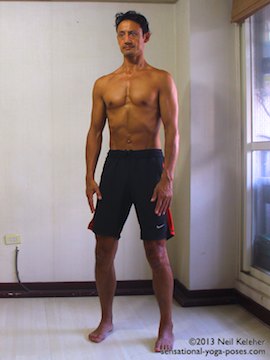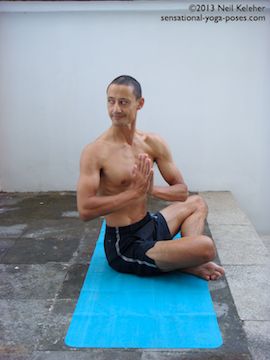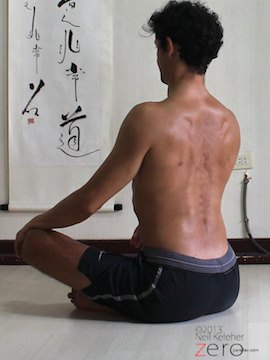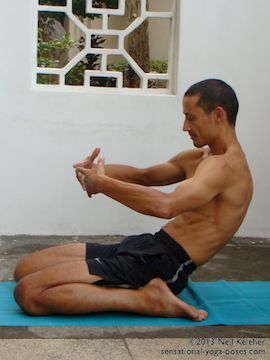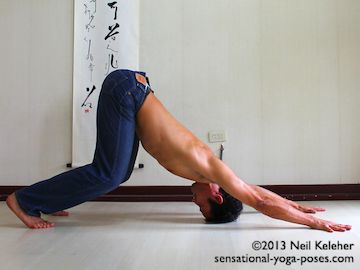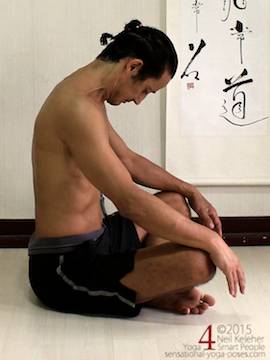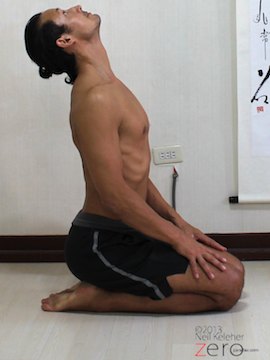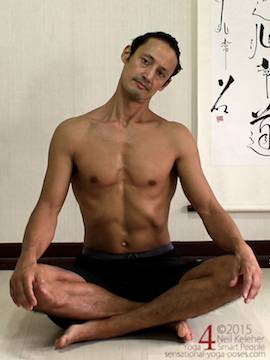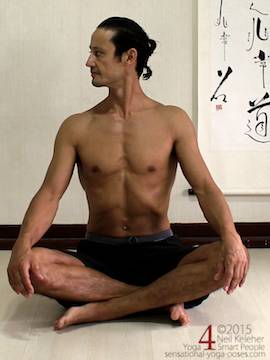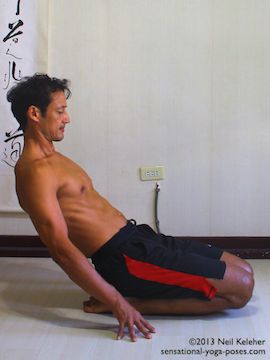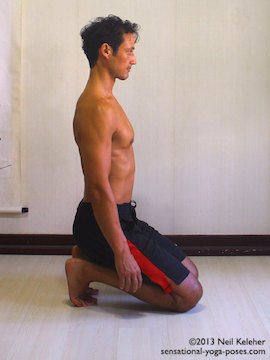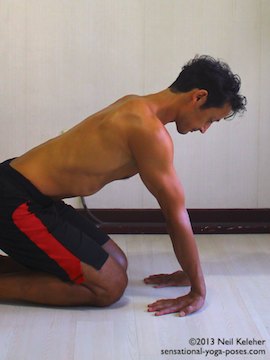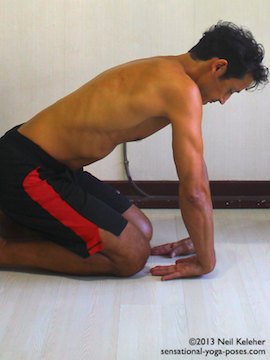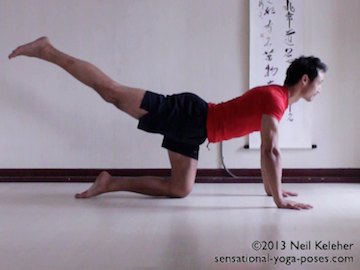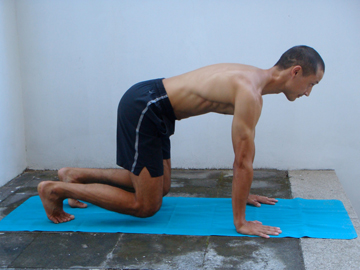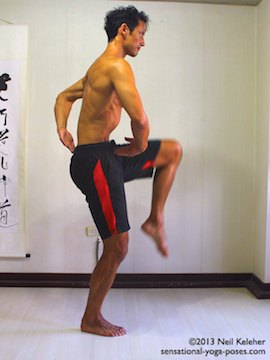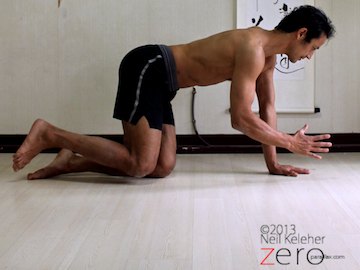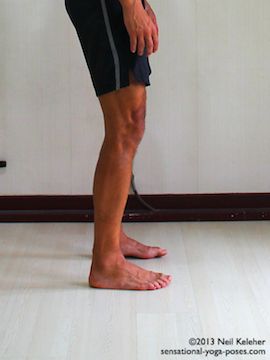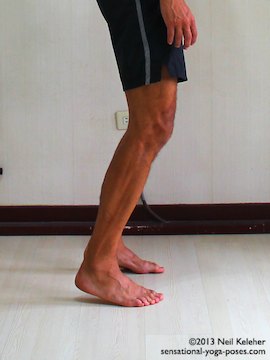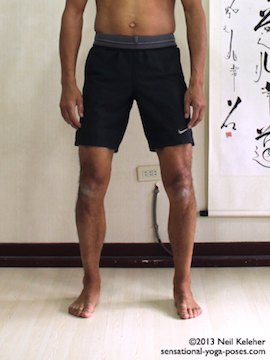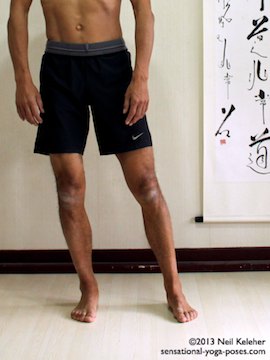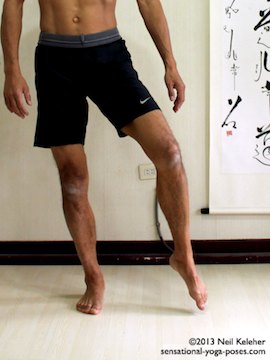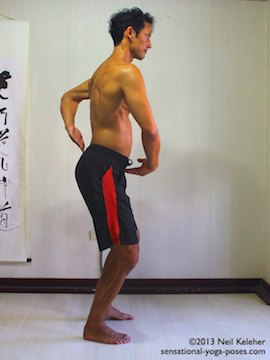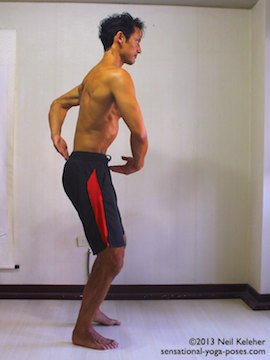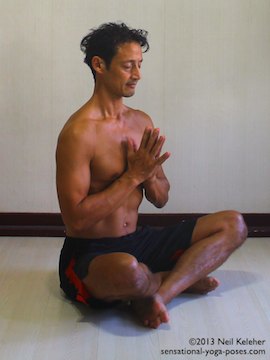Warming Up To Sun Salutes
When I first started doing yoga I learned Ashtanga yoga, and so in that system, the yoga pose warm up was sun salutations.
(There's two types in the Ashtanga system, Sun Salutation A and the slightly longer Sun Salutation B.)If you aren't in the mood for sun salutations (but still want to do them) you could start of with a simpler exercise, say rocking backwards and forwards on the feet.
Rocking forwards the aim would be to rock forwards to the point where pressure is even on toes and forefeet.
Rocking back the aim could be to rock back far enough that the toes can relax.
And then add on to these two actions by lengthening the spine while rocking forwards and then relaxing it while rocking back.
The intent in the first set of movements (rocking back and forwards) is to create increased body awareness by trying to stay balanced. In the second set of movements (lengthening and relaxing the spine) the intent is to become aware of the spine.
You can then you carry this awareness into doing the actual sun salutation.
Warming Up to Sun Salutations From a Seated Position
Another option for warming up to a sun salutation is to start from a seated position and perhaps start with spinal twists or spinal forwards bends and back bends.
And then from there put the hands forwards and step back to downward dog.
Since downward dog can be challenging, I might start with knees bent and focus first on feeling my hands (spreading the bones of the palms and the fingers adds tension making it easier to feel the hands as well as giving them an uncommon stretch.
I'll also notice my elbows.
For example, which way are they pointing? Are they symmetrical? What happens if I point them more to the sides or more to the back?
And I'll notice my shoulders. I like to use my shoulders to push my ribcage back, away from my hands in downward facing dog. Not everyone agrees with this but it feels good to me and if you are in doubt, then try both it and it's opposite. Which feels the best to you. (In the picture above I'm actually trying to reach my head to the floor.)
From downward dog I can move to standing and then start the next sun salutation from the beginning.
And the next time I get into down dog I can expand on the previous awareness exercises and work on lengthening my spine, straightening my knees and also reaching my heels to the floor.
In this case the focus isn't on pushing to get deeper, but rather on feeling the body and creating space so that I have room to easily move deeper. That's not to say some effort isn't involved, but it's finessed effort. Like feeling a key as you insert it into a lock rather than just jamming it in.
And that is in general how I like to do all yoga pose warm ups.
Tuning-in With Isolated Yoga Pose Warm Ups
If I'm teaching a class and not sure what I'll be teaching, I'll often start of with neck stretches followed by wrist and foot and ankle stretches.
These are parts of the body it is easy to ignore or forget about. Done in isolation it is easy to focus on feeling these parts while you are stretching them.
As an example, while twisting, side bend, front bending and back bending the neck, I like to focus on feeling the individual vertebrae of the cervical spine.
While stretching the toes and ankles I focus on feeling the feet. While doing weight bearing wrist stretches I focus on lifting my weight (so I'm not pushing on my wrist so much) and also on pushing my fingers down, whether the backs of my hands are facing upwards or on the floor.
That awareness can then be expanded to feeling other parts of the body.
A yoga pose warm up is not just to get the body warm, but to tune into the body, to feel it so that you then have a better idea of what to do and how to do it.
Yoga Pose Warm Ups for the Spinal Column
If I start with seated spinal backbends, the first focus can be on feeling the bones of the spine (the vertebrae) moving relative to each other. The next challenge can be that of feeling the muscles that cause the back bend, the spinal erectors.
And then the next challenge can be to deepen the back bend by intensifying the contraction of the spinal erectors.
The balancing action is to practice bending the spine forwards while using the abdominal and intercostal muscles. (The intercostals are similiar in orientation to the obliques but they act between adjacent ribs as opposed to between the ribs and pelvis.)
These actions could then be followed by poses like extended cat pose where you focus on activating spinal erectors and the back of the lifted leg. And one possible compliment, dog pose, with knees lifted, or the standing knee raise.
Sometimes I like to warm up first with seated twists, focusing on feeling the individual vertebrae. Then I might stand and focus on side bends, while using the muscles along the side of the body to deepen the side bend.
Warming Up with Balancing Cat Pose
Another fun way to start of a yoga practice, while developing concentration at the same time is to work on variations of balancing cat pose.
This is where the leg and arm on the same side are both lifted.
Rather than holding, I'll initially focus on weight shifting first. (This is a type of balance exercise.)I might shift the hips to the side, then lift the leg, then shift the ribcage, then reach the arm. Then return to center and repeat, changing sides each time.
Some standing exercises I like to start of with can include the shifting back and forwards as mentioned above. But this can turn into shifting forwards and lifting the heels, then lowering the heels and rocking back. Then I'd add: moving the shoulders forwards (spreading the shoulder blades), reaching the arms forwards (while keeping the shoulder blades spread), then lifting the arms (again keeping the spread feeling between the shoulders blades.)
This can turn into a smooth rhythmic exercise.
And then after a few repetitions, hold the forward position with arms up, and optionally bring the palms together.
This could be followed by chair pose or squats, slowly lowering into chair pose and slowly standing up (or starting from a low relaxed position and moving up into a squat).
Then to rest the legs while still working, follow with a standing side bend.
The squats have the happy affect that they can create awareness as well as warm your body up.
Weight Shifting:
Gentle Yoga Pose Warm Ups
More gentle standing exercises include sideways weight shifts (another balance exercise) where I shift my weight from center to one leg and back again. I might add a knee raise to the front or the side or reach a leg back.
Another alternative to develop ab awareness is to first practice pulling the lower belly in and up while standing with knees slightly bent. The low tailbone drops and you can look for a feeling of openness in the lower back. From there you can shift to one leg and lift the other knee, and if you like straighten it. Then release and repeat, swapping sides each time.
For leg stability you can focus on standing on one leg, activate the inner and outer thigh and hip muscles then bend forwards and stand up while keeping those muscles engaged. Repeat, switching sides each time. You can do the same moving into half moon pose.
Yoga Pose Warm Ups for Flexibility
If you're focus is on improving flexibility then you can pick a stretch to start with and focus on gradually deepening the stretch. Try a short hold to begin with, rest or change sides and then repeat, this time seeing if you can stay longer or go deeper (or both.)
If you find you are tight, then repeat the pose a few times, changing sides if it is asymmetrical or picking two or three yoga stretches to move between.
Then after you've finished your stretches, then do some strengthening work so that you reactivate the muscles that you've just stretched.
If you do lots of shoulder stretches, then do arm strengthening poses. If you do lots of leg stretches, particularly inner thigh stretches, then do some leg strengthening or standing yoga poses to reactivate stretched muscles.
For improving flexibility I've found that it is more effective to stretch cold or cool. To prevent injury while stretching I focus on moving into any stretch gradually and smoothly while at the same time paying attention to my body so that I can stop if something doesn't feel right.
However that is my experience. If that doesn't work for you or you'd rather be warm to stretch, then start with some strengthening yoga poses or use simple movements like weight shifts prior to stretching.
Ask Your Higher Self (Or Your Inner Self) Where to Start
If you still aren't sure where to start, then sit with your legs crossed, put your hands together and focus on being still for a few moments. Ask yourself (or god) what you want to get out of your practice. As soon as you have an idea, then start there.
Looking Back on Your Practice
While the focus on this article was yoga pose warm ups, what to do to begin a yoga practice I feel I should also talk about the end.
Not all practices will be perfect. Not all practices will feel good. However, if you open to the idea of exploring your body and learning it then each practice can be an opportunity to learn.
And if you think that you've just had a crappy practice, then at the end, look back and see if you've learned anything. Then maybe your practice won't seem as bad.
Likewise with your warm ups. Experiment. See what works and what doesn't. And so that you reduce the risk of injury while dong yoga poses, practice moving slowly and smoothly both while doing yoga pose warm ups and while moving in and out of yoga poses.
If You Are Short On Time
If you are short on time, rather than trying to pack a lot in, pick one or two poses to work on.
Or think of an element of a pose that gives you trouble. Try to isolate that yoga pose element (or brush stroke) and figure out an exercise to help you improve that element.
One other way to warm up is with dance of shiva. (If you aren't sure about how to isolate body parts, dance of shiva can be a good way to practice.)
This can be done in five minutes a day and can be an excellent boost for concentration and body awareness. It's also a great way to exercise the shoulders and arms.
Published: 2011 04 24
Updated: 2021 01 24
